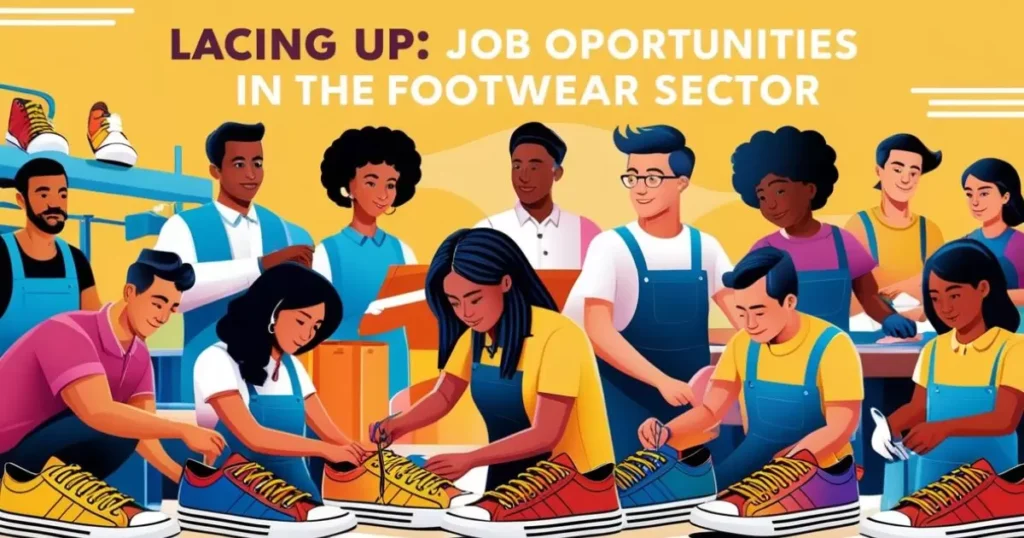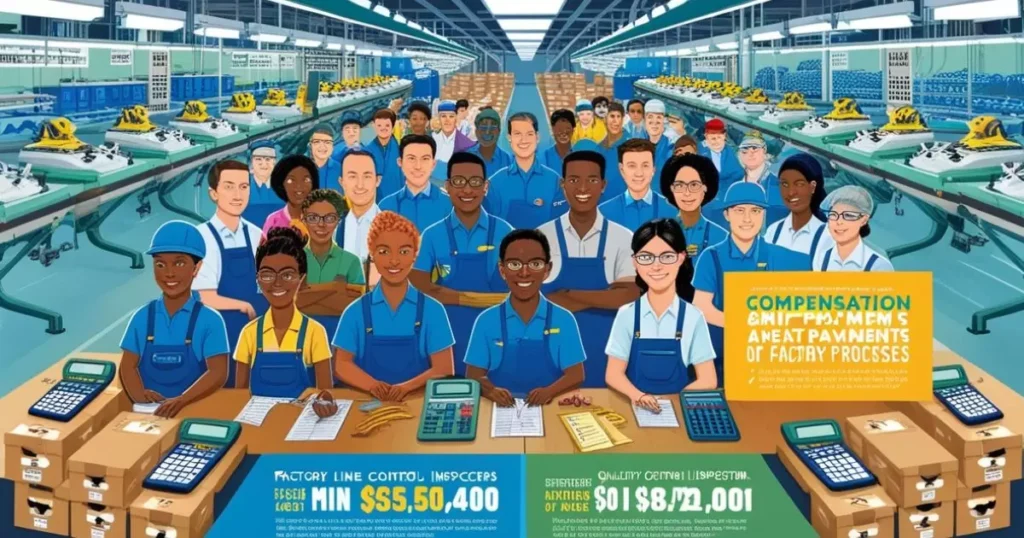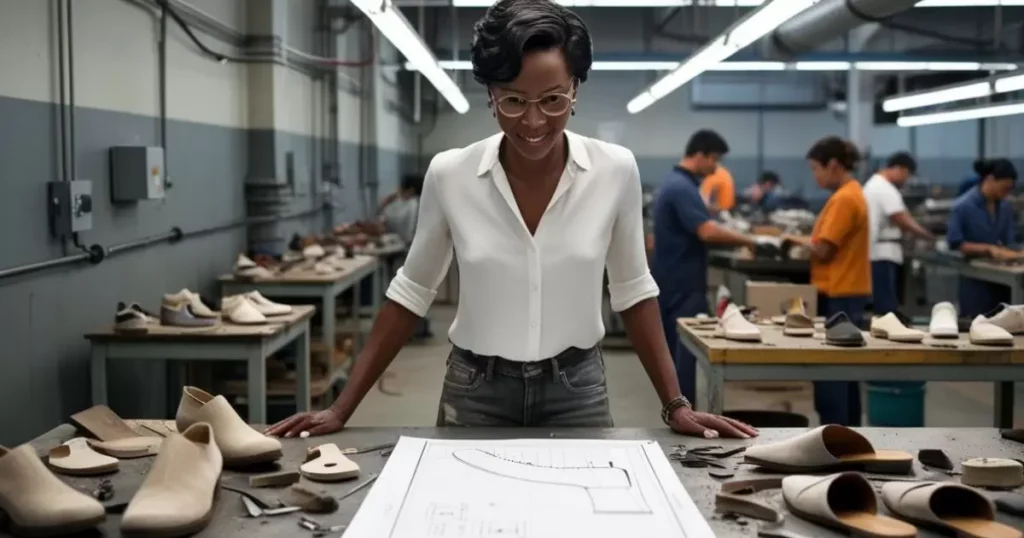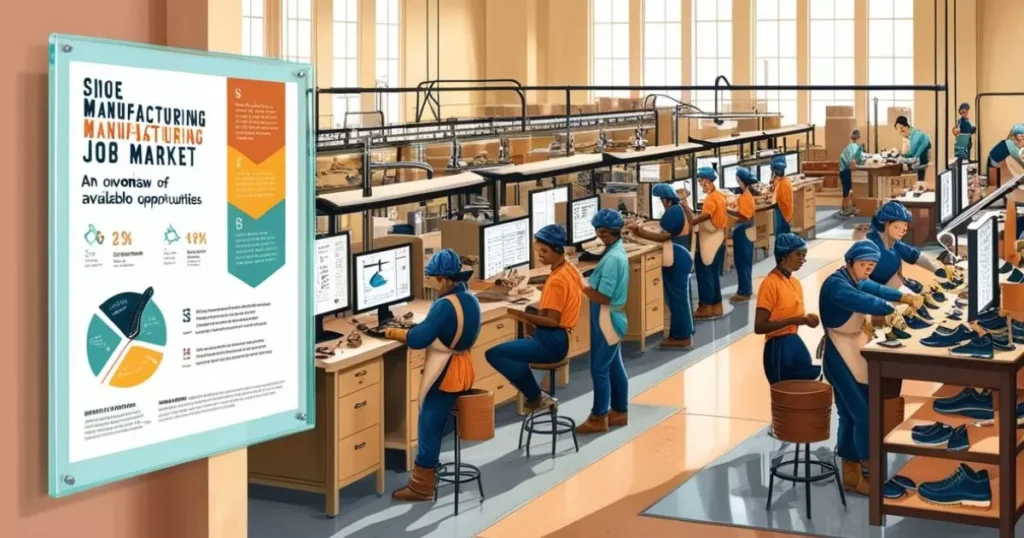In today’s fast-paced world, the shoe manufacturing industry stands as a testament to human ingenuity and adaptability. From the bustling factories of Asia to the high-tech labs of Europe, opportunities abound for those willing to put their best foot forward. Let’s lace up and take a comprehensive look at the shoe manufacturing job market, exploring the myriad opportunities available to both seasoned professionals and newcomers alike.
The Current Landscape of Shoe Manufacturing Jobs
The global footwear industry isn’t just walking—it’s running at full speed. In 2023, the market size hit a staggering $365.5 billion, with projections suggesting it’ll reach $530.3 billion by 2027. This growth isn’t just about more shoes; it’s about smarter, more sustainable, and highly customized footwear.
Global Snapshot: Key Players and Production Hubs
The shoe manufacturing landscape is as diverse as the shoes it produces. Here’s a quick look at the major players:
- China: Still the undisputed champion, producing over 13 billion pairs annually
- India: Runner-up with 2.6 billion pairs
- Vietnam: A rising star, manufacturing 1.4 billion pairs
- Indonesia: Close behind with 1.3 billion pairs
- Brazil: Leading the Americas with 908 million pairs
But it’s not just about quantity. Countries like Italy and Portugal are carving out niches in high-end, luxury footwear, while the USA leads in athletic and performance shoe innovation.
Regional Breakdown
Asia-Pacific Dominance
The Asia-Pacific region continues to be the powerhouse of shoe manufacturing. Why? Let’s break it down:
- Cost-effective labor: Despite rising wages, countries like Vietnam and Indonesia still offer competitive labor costs
- Established supply chains: Decades of manufacturing have created robust networks of suppliers and skilled workers
- Government support: Many Asian countries provide incentives for manufacturing sectors
However, it’s not all smooth sailing. Rising labor costs and increasing automation are shifting the landscape. Countries like Cambodia and Myanmar are emerging as new hotspots for labor-intensive processes.
Emerging Markets in Africa and Latin America
Africa and Latin America are stepping up their game in the shoe manufacturing arena. Here’s what’s driving their growth:
- Ethiopia: Dubbed the “New China” in footwear, with major brands like Huajian Group investing heavily
- Mexico: Benefiting from proximity to the US market and the USMCA trade agreement
- Brazil: A powerhouse in Latin America, known for its strong domestic market and leather expertise
These regions offer a compelling mix of lower labor costs, improving infrastructure, and strategic locations for serving major markets.
Specialty Manufacturing in Europe and North America
While mass production has largely moved to Asia, Europe and North America have found their footing in specialized segments:
- Italy: Renowned for luxury leather shoes, with brands like Gucci and Prada
- Portugal: Emerging as a hub for high-quality, sustainably produced footwear
- USA: Leading in athletic and performance shoe innovation, home to Nike and New Balance
These regions focus on high-value-added production, leveraging advanced technology and skilled craftsmanship.
Industry-Shaping Trends
The shoe manufacturing industry is walking into the future with some game-changing trends:
- Automation and AI Integration
- Robotic assembly lines increasing efficiency by up to 20%
- AI-driven design processes reducing time-to-market by 30%
- Sustainable and Eco-Friendly Production
- Use of recycled materials growing by 15% annually
- Water-based adhesives reducing VOC emissions by 65%
- Customization and On-Demand Manufacturing
- 3D printing enabling small-batch production
- Digital foot scanning for perfect fits, reducing returns by 25%
These trends aren’t just reshaping how shoes are made; they’re creating entirely new job categories and skill requirements.
Lacing Up: Job Opportunities in the Footwear Sector

The shoe manufacturing job market is as diverse as the shoes on your local store shelf. Let’s walk through the various roles available:
Factory Floor Positions
These are the backbone of the industry, where the rubber meets the road (or in this case, where the sole meets the upper).
- Machine Operators and Technicians
- Skills needed: Mechanical aptitude, attention to detail
- Average salary: $30,000 – $45,000 per year
- Growth outlook: Stable, with increasing emphasis on technical skills
- Quality Control Specialists
- Key responsibilities: Ensuring shoes meet stringent quality standards
- Required qualifications: Eye for detail, knowledge of materials science
- Salary range: $35,000 – $55,000 annually
- Assembly Line Workers
- Tasks: From cutting materials to final packaging
- Essential traits: Dexterity, stamina, teamwork
- Compensation: $25,000 – $40,000 yearly, often with performance bonuses
Design and Development Roles
For those with a creative flair and an eye for style, these positions offer a chance to shape the future of footwear.
- Footwear Designers
- What they do: Conceptualize and sketch new shoe designs
- Required skills: Artistic ability, knowledge of fashion trends, CAD proficiency
- Earning potential: $50,000 – $120,000+, depending on experience and employer
- Pattern Makers
- Responsibilities: Translating designs into functional patterns
- Key skills: Spatial awareness, technical drawing, material knowledge
- Salary range: $40,000 – $70,000 per year
- Materials Specialists
- Focus: Sourcing and developing innovative shoe materials
- Required expertise: Chemistry, textile science, sustainability practices
- Compensation: $45,000 – $85,000 annually
Technology-Driven Careers
As the industry strides into the future, these roles are becoming increasingly crucial:
- 3D Modeling Experts
- What they do: Create digital shoe models for prototyping and marketing
- Essential skills: Proficiency in 3D software, understanding of shoe construction
- Salary potential: $60,000 – $100,000 per year
- Robotics Engineers
- Responsibilities: Designing and maintaining automated production systems
- Required background: Robotics, mechanical engineering, programming
- Earning range: $70,000 – $120,000+ annually
- Data Analysts for Production Optimization
- Focus: Using big data to improve efficiency and reduce waste
- Key skills: Statistical analysis, machine learning, industry knowledge
- Compensation: $65,000 – $110,000 yearly
Sustainability-Focused Positions
As the industry pivots towards eco-friendly practices, these roles are stepping into the spotlight:
- Environmental Compliance Officers
- Duties: Ensuring factories meet environmental regulations
- Required knowledge: Environmental law, sustainability practices
- Salary range: $50,000 – $90,000 per year
- Recycling and Upcycling Specialists
- What they do: Develop processes for reusing materials
- Key skills: Material science, circular economy principles
- Earning potential: $45,000 – $80,000 annually
- Sustainable Materials Researchers
- Focus: Developing eco-friendly alternatives to traditional materials
- Required background: Chemistry, materials science, environmental studies
- Compensation: $60,000 – $100,000+ yearly
Stepping Up: Education and Skills for Success
In the ever-evolving world of shoe manufacturing, staying a step ahead requires the right mix of education and skills.
Traditional Pathways
- Vocational Training Programs
- Duration: 6 months to 2 years
- Focus: Hands-on skills in shoe construction and repair
- Benefits: Quick entry into the workforce, practical skills
- Apprenticeships in Shoemaking
- Length: 2-4 years
- Advantages: Learn from master craftsmen, earn while you learn
- Best for: Those interested in high-end or bespoke shoemaking
- Degrees in Fashion Design or Industrial Engineering
- Duration: 3-4 years
- Pros: Broad knowledge base, networking opportunities
- Career paths: Design, product development, production management
Emerging Skill Sets
As technology reshapes the industry, these skills are becoming increasingly valuable:
- 3D Design Software Proficiency
- Key software: Rhino, SolidWorks, AutoCAD
- Applications: Rapid prototyping, virtual sampling
- Impact: Reduces time-to-market by up to 40%
- Understanding of Smart Textiles and Wearable Tech
- Focus areas: Conductive fabrics, embedded sensors
- Potential applications: Performance tracking shoes, adaptive cushioning
- Market growth: Expected to reach $5.55 billion by 2025
- Knowledge of Sustainable Manufacturing Practices
- Key concepts: Circular economy, zero-waste design
- Certifications: Cradle to Cradle, Global Recycled Standard
- Industry impact: 65% of consumers prefer eco-friendly footwear
Soft Skills That Shine
Don’t underestimate the power of these non-technical skills:
- Adaptability in a Rapidly Changing Industry
- Why it matters: Keeps you relevant as technology evolves
- How to develop: Continuous learning, embracing change
- Cross-Cultural Communication for Global Operations
- Importance: Essential for managing global supply chains
- Tips: Learn a second language, study cultural business practices
- Problem-Solving in High-Pressure Production Environments
- Key trait: Ability to think on your feet
- How to improve: Practice scenario-based problem-solving, learn from experienced mentors
Show Me the Money: Compensation in Shoe Manufacturing

Let’s talk dollars and cents—or should we say euros and yen? Compensation in the shoe manufacturing industry varies widely based on role, experience, and location.
Salary Ranges by Job Category
| Job Category | Entry-Level | Experienced | Top Earners |
| Factory Floor | $25,000 – $35,000 | $35,000 – $50,000 | $50,000+ |
| Design | $40,000 – $60,000 | $60,000 – $100,000 | $100,000+ |
| Technology | $50,000 – $70,000 | $70,000 – $120,000 | $120,000+ |
| Sustainability | $40,000 – $60,000 | $60,000 – $90,000 | $90,000+ |
Regional Pay Differences
- USA: Generally highest salaries, especially in tech roles
- Europe: Competitive pay, strong benefits in countries like Germany
- Asia: Lower base salaries, but often with significant growth potential
Benefits Packages
- Health and Retirement Plans
- Health insurance: Standard in most large companies
- 401(k) or equivalent: Often with company matching up to 3-6%
- Professional Development Opportunities
- Continuing education stipends: $500 – $2,000 annually
- Conference attendance: 1-2 industry events per year
- In-house training programs: Especially common in larger corporations
Non-Traditional Perks
- Employee Shoe Allowances
- Annual value: $200 – $500 in free or discounted shoes
- Purpose: Familiarize employees with products, boost morale
- Sustainability Bonuses
- What: Financial incentives for eco-friendly innovations
- How much: 5-10% of base salary for significant contributions
- Impact: Encourages innovation, aligns with company values
Walking into the Future: Job Outlook and Industry Projections
The shoe manufacturing job market is evolving faster than you can say “cobbler.” Let’s lace up and sprint through the projections.
Growth Sectors
- Athletic and Performance Footwear
- Market size: Expected to reach $95.14 billion by 2025
- Job growth: 4-6% annually in related roles
- Hot jobs: Biomechanics specialists, performance materials engineers
- Sustainable Shoe Lines
- Consumer demand: 73% of millennials willing to pay more for eco-friendly shoes
- Industry response: Major brands pledging 100% sustainable materials by 2030
- Emerging roles: Circular economy strategists, bio-based material developers
- Smart Shoes and Wearable Tech Integration
- Market projection: $6.51 billion by 2027
- Key players: Nike, Under Armour, Xiaomi
- Career opportunities: IoT specialists, app developers for shoe-based health tracking
Potential Declines
- Traditional Mass-Production Roles
- Automation impact: 20-30% of current jobs at risk in the next decade
- Most affected: Assembly line workers, basic machine operators
- Advice for workers: Upskill in machine maintenance or quality control
- Regions Facing Increased Labor Costs
- Affected areas: Coastal China, parts of Southeast Asia
- Industry response: Shifting to interior regions or neighboring countries
- Opportunities: Roles in supply chain management, relocation logistics
Factors Influencing Job Availability
- Trade Policies and Tariffs
- Impact: Can shift production between countries rapidly
- Example: US-China trade tensions boosting manufacturing in Vietnam
- Job implications: Increased demand for trade compliance specialists
- Consumer Trends Towards Sustainability
- Stat: 66% of global consumers willing to pay more for sustainable goods
- Industry response: Major investments in recycling and sustainable materials
- Career growth: Environmental impact assessors, sustainable supply chain managers
- Technological Advancements in Manufacturing
- Key tech: 3D printing, AI-driven design, robotics
- Efficiency gains: Up to 30% reduction in production time
- New roles: 3D print technicians, AI model trainers for shoe design
Navigating Challenges in Shoe Manufacturing Careers

Like a pair of ill-fitting shoes, challenges in this industry can cause discomfort if not addressed properly. Let’s walk through some strategies to keep your career path smooth.
Addressing Automation Anxiety
The rise of robots doesn’t mean humans are out of step. Here’s how to stay in the dance:
- Embrace the Change
- Mindset shift: See automation as a tool, not a threat
- Action step: Learn to operate and maintain automated systems
- Develop Complementary Skills
- Focus on: Problem-solving, creative thinking, and interpersonal skills
- Why: These are areas where humans still outpace machines
- Continuous Learning
- Stay updated: Follow industry publications like “Footwear News”
- Invest in yourself: Consider online courses in emerging technologies
Strategies for Staying Relevant in a Changing Industry
- Network, Network, Network
- Join professional organizations: International Footwear Association (IFA)
- Attend trade shows: MICAM in Milan, FN Platform in Las Vegas
- Benefits: Stay informed about trends, discover job opportunities
- Develop a T-Shaped Skill Set
- What it means: Deep expertise in one area, broad knowledge in many
- Example: Deep knowledge in leather crafting, broad understanding of supply chain and sustainability
- Embrace Sustainability
- Why: It’s not just a trend, it’s the future of the industry
- How: Get certified in sustainable practices, propose eco-friendly initiatives at work
Balancing Craftsmanship with Technological Innovation
The art of shoemaking meets the science of advanced manufacturing. Here’s how to find your footing:
- Blend Old and New
- Learn traditional methods: Hand-stitching, leather selection
- Apply modern tech: Use 3D modeling for traditional designs
- Focus on Quality Over Quantity
- Develop an eye for detail: Crucial in both handmade and tech-driven production
- Emphasize value: High-quality, durable shoes are becoming more desirable
- Collaborate Across Disciplines
- Team up: Work with both master craftsmen and tech experts
- Result: Innovative designs that respect traditional techniques
Success Stories: Profiles of Shoe Industry Professionals
Let’s walk a mile in the shoes of those who’ve made it big in the industry. Their stories offer inspiration and practical insights for your own career journey.
From Assembly Line to Design Studio: A Career Evolution
Meet Maria Chen, Senior Designer at Nike
Maria started her career as an assembly line worker in a shoe factory in Guangdong, China. Her journey to becoming a senior designer at Nike is nothing short of inspirational.
- Key Steps in Her Journey:
- Learned every aspect of shoe construction on the factory floor
- Took night classes
Frequently Asked Questions
- What are the most in-demand jobs in shoe manufacturing right now?
A: The most sought-after roles include 3D modeling experts, sustainable materials researchers, and robotics engineers. There’s also high demand for skilled pattern makers and footwear designers who can blend traditional craftsmanship with modern technology.
- Do I need a specific degree to work in shoe manufacturing?
A: Not always. While degrees in fashion design, industrial engineering, or materials science can be beneficial, many roles value practical skills and experience. Vocational training, apprenticeships, and on-the-job learning are also valid pathways into the industry.
- How is automation affecting job prospects in shoe manufacturing?
A: Automation is changing the landscape, particularly for traditional assembly line roles. However, it’s also creating new opportunities in areas like machine maintenance, robotics programming, and production optimization. The key is to adapt and acquire skills that complement automated processes.
- What’s the salary range for jobs in the shoe manufacturing industry?
A: Salaries vary widely based on role, experience, and location. Entry-level factory floor positions might start around $25,000-$35,000 annually, while experienced designers or tech specialists can earn $100,000+. Sustainability experts and high-level managers often fall in the $60,000-$120,000 range.
- Are there opportunities in sustainable shoe manufacturing?
A: Absolutely. Sustainability is a major growth area in shoe manufacturing. Roles like environmental compliance officers, recycling specialists, and sustainable materials researchers are increasingly in demand as the industry shifts towards more eco-friendly practices.

An author is a creator of written content, producing works ranging from books and articles to blog posts and essays. They use their creativity, knowledge, and research to inform, entertain, or persuade readers. Authors often have a unique voice and perspective, contributing significantly to literature and various media.

